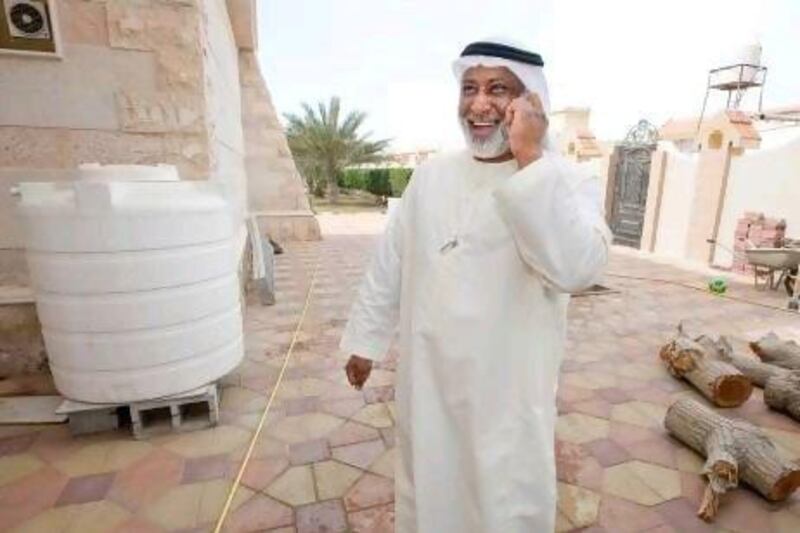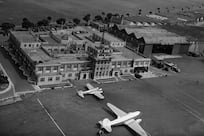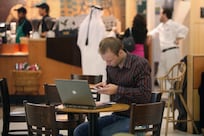UMM AL QUWAIN // In a place where water shortages are a fact of life, a simple water tank will just not do.
That is why the Umm Al Quwain resident Saif Hassan, 48, has installed three of them in his spacious villa in the town's Al Hadith area.
"We have three tanks - one for the yard, another for the house and a third one for cooking," said Mr Hassan, a businessman who, like many of the emirate's men, used to work in the army.
The first tank is filled by two groundwater wells and is used to irrigate a garden of decorative shrubs and a small vegetable patch.
The water provided by the utility service is used in the house for cleaning and washing.
The water in the third container is used for cooking and is brought in by tanker about once a week. The nine-member household drinks bottled water.
The system ensures Mr Hassan and his family have a safe water supply, and makes it a little easier to deal with the water cuts that occur once every three to five days in the area. The interruptions last from three hours to half a day.
"The pipe network is very old and there is leakage everywhere, and a lot of times they cut the water," he said.
When The National visited Umm Al Quwain, finding a small leak took about 15 minutes of driving around the town.
The Federal Electricity and Water Authority (Fewa) pipes, which are slightly bigger in diameter than a garden hose, can easily be seen sticking up from the sandy soil and snaking their way to residents' houses. Fewa would not respond to multiple requests over a long period of time for information about the water pipes there.
Like his fellow citizens, Mr Hassan is awaiting the completion of an upgrade to the town's pipe network to bring in water from the desalination plant in Fujairah.
"You cannot imagine in this time a country like the UAE has this problem," he said. "The pipeline is from 40 years, it is so old. To replace it needs time. Until they finish there is a problem we face."
Yousef Sultan, 37, a retired army officer who lives in Al Humrah, has employed a similar strategy to deal with the water shortages.
Five years ago Mr Sultan installed a larger water tank in his house, increasing its storage capacity to more than 15,000 litres from 3,700.
"It lasts for three to four days," he said. "It is enough to cover us in times of shortage."
The family of Saif, a government employee who did not wish to give his last name, employs another tactic. "Sometimes when this happens we leave the house and go to relatives in other emirates," said Saif, 25.
Apart from the reliability of the supply, the quality of tap water is a concern, too.
When The National hada sample of Umm Al Quwain water tested in a Dubai laboratory, the result showed the water has high levels of dissolved minerals.
At 1,440 milligrams a litre (mgl), the amount of particles suspended in the water and mineral ions dissolved in it were higher than the limits set by the World Health Organisation (WHO), which allow for a maximum of 1,000mgl.
The most common mineral in the water was chloride. While the recommended limit is 250mgl, the sample contained 699mgl. The water also had high amounts of nickel - 0.13mgl, compared with the 0.02mgl set by the WHO. The sample was taken from Mr Hassan's home.
"Every month, you see four or five places leaking and the water is not sweet, it is salty," said Rashid Al Ali, 50, a retired army officer. "Many people have problems with their skin and hair."
There is another problem residents face. In the new neighbourhood of Salama, about 20 minutes by car from the old town, there is row upon row of new, luxurious villas, still awaiting their residents.
Owners in many of these properties have not been able to move in as electricity and water services are yet to be hooked up to many parts of the new area. Some homeowners have been waiting for months, residents said.
Mr Al Ali is building a house in the area. He started in 2005 and is six months away from completion, but is still waiting for water services.
He is confident his wait will not be too long, however, as his new neighbourhood is already inhabited.
"In some areas it is coming quickly, but in some areas it is taking time," Mr Al Ali said.
* The Umm Al Quwain samples were obtained last month, following procedures specified by Core Laboratory in Dubai, where the samples were later tested.
The end of the tap was cleaned with an anti-bacterial wipe. The tap was turned on and the water left running for one minute before two samples, each a litre in volume, were taken.
The samples were preserved in cold storage and taken to the laboratory where technicians looked for the presence of disease-causing microbes and also analysed the water’s chemical content based on 17 parameters.
The samples were analysed in terms of their conductivity, pH balance, and what experts call total solids – the amount of suspended and dissolved solids in the water.
The testing also measured the amount of minerals such as chloride, sulphate, fluoride, cyanide and residual chlorine, and the amount of trace metals such as copper, iron, lead and others, was also measured.
The results were compared to guidelines established by the World Health Organisation (WHO) and the Gulf Standards Organisation.
At 1,440 milligrams a litre (mgl), the water had a higher amount of total dissolved solids than limits set by the WHO, which allows for 1,000mgl.
There were also high levels of chloride at 699mgl, compared with the 250mgl specified by the WHO. The amount of nickel was also high – 0.13mgl compared with the safe limit of 0.02mgl set by the WHO.





